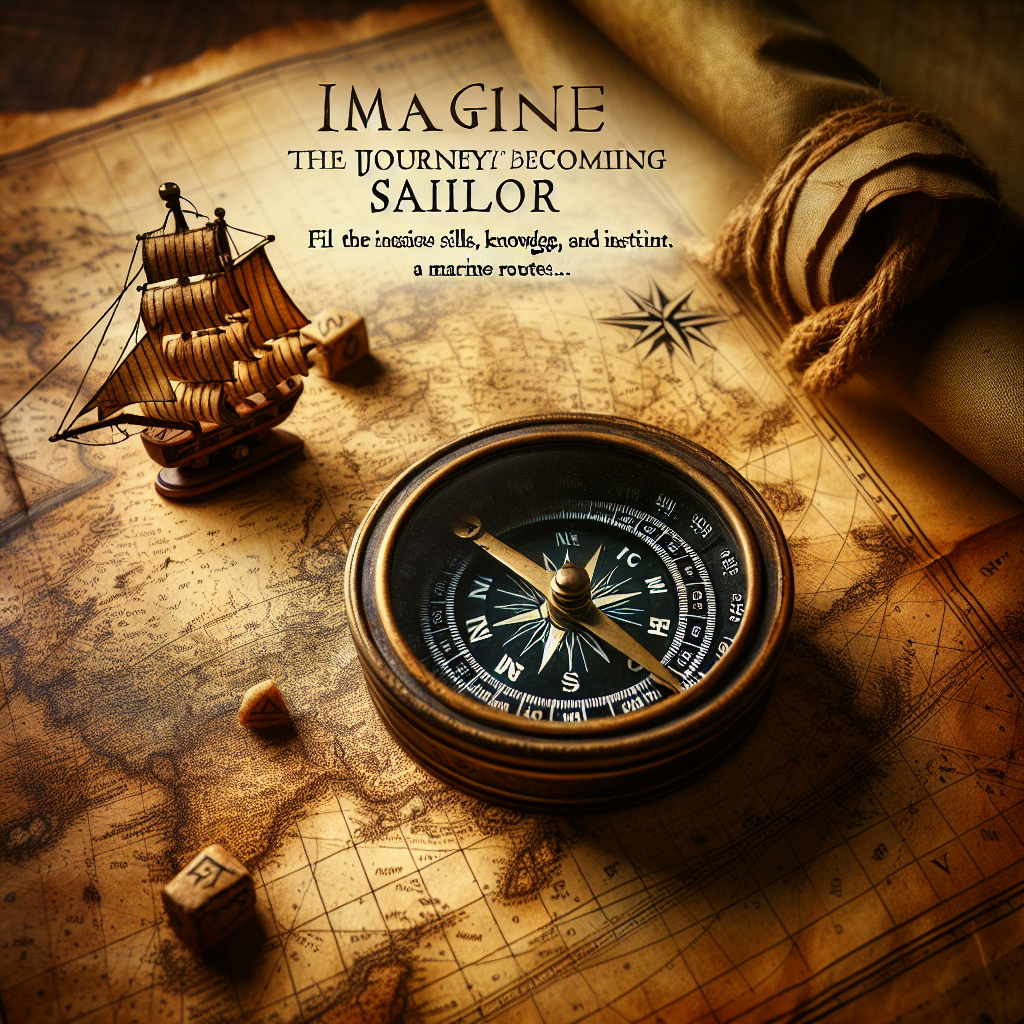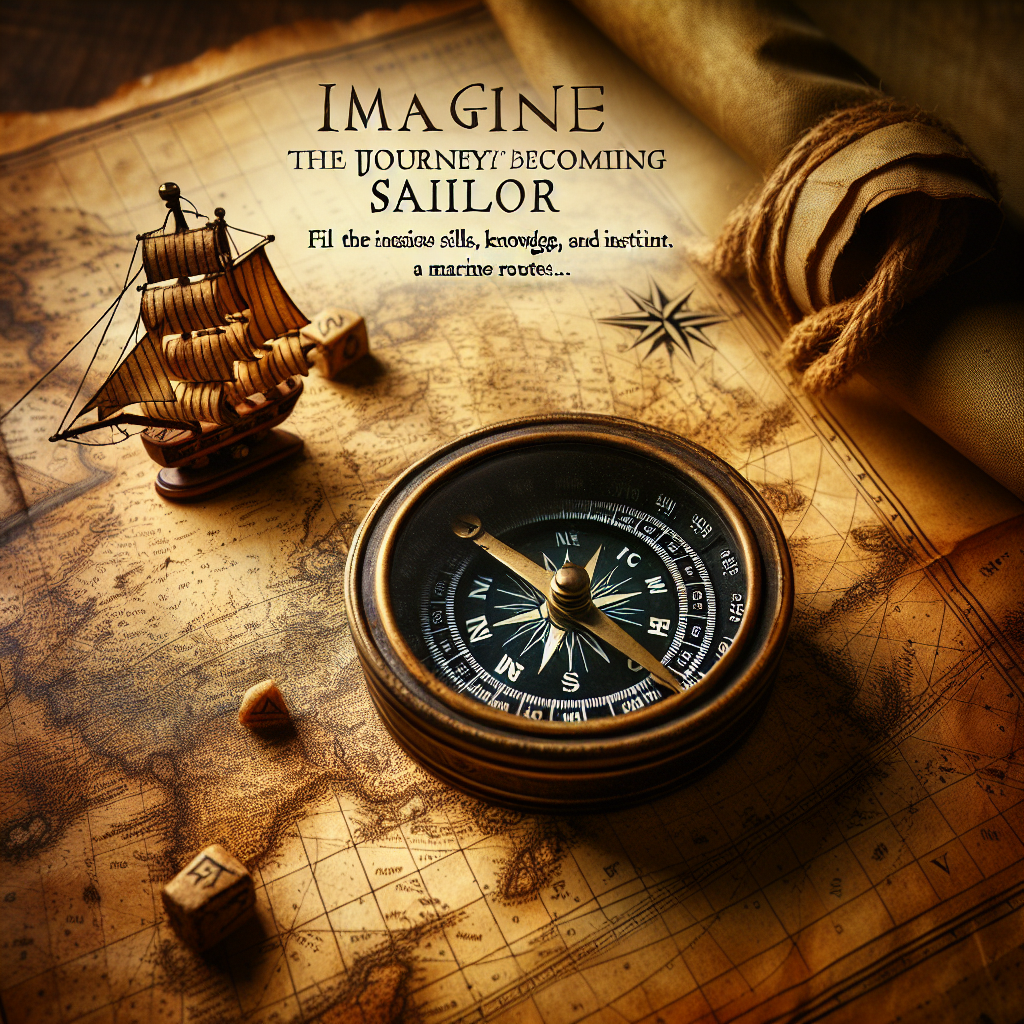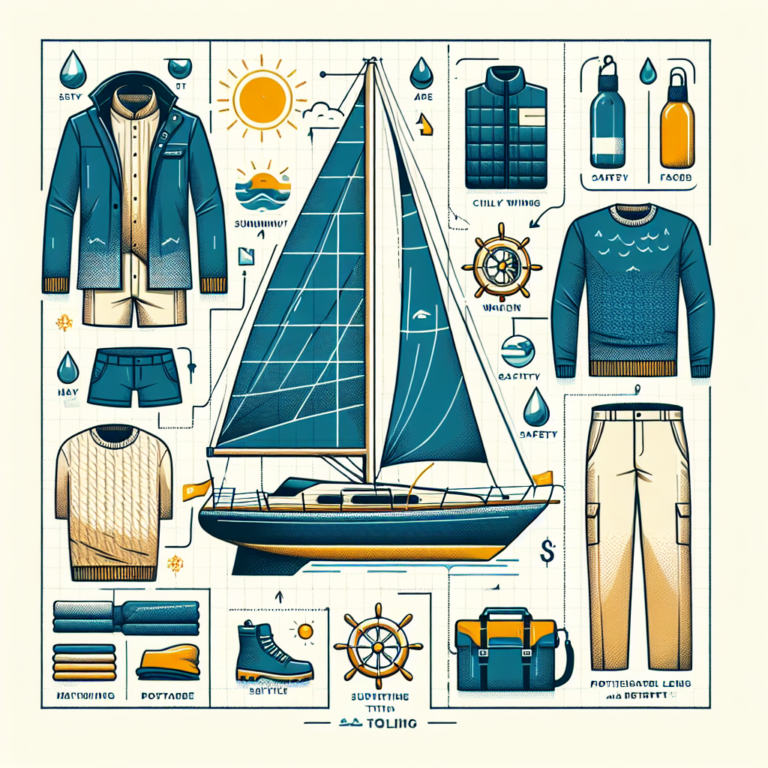How To Become A Sailor
So, you’ve always dreamed of sailing the open seas, feeling the wind in your hair and the salty breeze on your face. Well, look no further because this article is here to fulfill your seafaring aspirations. In this guide on how to become a sailor, we’ll cover the steps, skills, and mindset required to embark on this thrilling and adventurous journey. From obtaining the necessary certifications to learning the art of navigation, you’ll soon be ready to set sail and navigate your way through the vast blue expanse. So, grab your compass and get ready for an exhilarating ride towards becoming a seasoned sailor.

Understanding the Basics of Sailing
Sailing is an exhilarating activity that allows you to explore the open seas powered only by the wind. Before embarking on this exciting journey, it’s essential to understand the basics of sailing. This knowledge will ensure your safety, enhance your experience, and enable you to navigate through the water with confidence.
Different Types of Sailing
Sailing comes in various forms, each with its unique characteristics and demands. Some common types of sailing include:
-
Cruising: Cruising involves leisurely sailing on a yacht or sailboat for extended periods, often with overnight stays onboard. It emphasizes comfort and relaxation while enjoying the serenity of the open water.
-
Racing: Sailing races are competitive events, where participants maneuver their boats to complete a designated course in the shortest time possible. Racing requires precision, strategy, and teamwork.
-
Offshore Sailing: Offshore sailing ventures farther into the open sea and involves longer journeys, usually lasting several days or even weeks. It demands resilience, self-sufficiency, and the ability to navigate through varying weather conditions.
-
Day Sailing: Day sailing refers to shorter excursions, usually within a day, where sailors enjoy the pleasure of being on the water without overnight stays. It is ideal for beginners and those who prefer shorter trips.
-
Crewed Charter: Crewed charter sailing involves renting a boat and recruiting a professional crew to handle the navigation and yacht maintenance. It allows you to enjoy the sailing experience without the responsibilities of operating the boat yourself.
Essential Sailing Terminology
To effectively communicate and understand sailing instructions and techniques, it’s vital to familiarize yourself with common sailing terminology. Here are a few essential terms you should know:
-
Starboard: The right side of the boat when facing the bow (front).
-
Port: The left side of the boat when facing the bow.
-
Bow: The front part of the boat.
-
Stern: The back part of the boat.
-
Windward: The side of the boat facing into the wind.
-
Leeward: The side of the boat sheltered from the wind.
-
Tacking: Changing the direction of the boat by turning the bow into the wind.
-
Jib: A type of sail located in front of the mast.
-
Mainsail: The primary sail that extends behind the mast.
-
Boom: The horizontal pole that extends from the mast to the bottom of the mainsail.
These are just a few examples of sailing terminology, but learning and understanding these terms will help you navigate the sailing world more efficiently.
Basic Sailing Skills and Techniques
To become a proficient sailor, mastering some fundamental skills and techniques is essential. These skills will ensure your safety, help you handle the boat effectively, and enable you to navigate through different weather conditions. Here are a few basic sailing skills you should focus on:
-
Sail Trim: Understanding how to adjust the sails properly according to wind direction is crucial for optimal performance and stability.
-
Steering: Learning to steer the boat accurately, taking into account wind angles and currents, is vital for maintaining the desired course.
-
Tacking and Jibing: Knowing how to change the direction of the boat by tacking (turning into the wind) or jibing (turning away from the wind) is a fundamental skill in sailing.
-
Man Overboard: Being able to execute a man overboard maneuver swiftly and efficiently will help you rescue someone who has fallen overboard.
-
Knot Tying: Familiarizing yourself with various knots used in sailing, such as the figure-eight knot, bowline, and cleat hitch, will ensure your boat is securely tied and organized.
By practicing and honing these skills, you’ll be well-prepared to navigate the challenging waters and enjoy a fulfilling sailing experience.
Knowing the Prerequisites
Before embarking on a sailing journey, it’s crucial to understand the prerequisites and requirements associated with becoming a sailor. This will ensure that you are physically capable, meet the necessary age restrictions, possess the relevant educational background, and have adequate swimming proficiency.
Physical Fitness and Health Requirements
Sailing can be physically demanding, so it’s essential to have a reasonable level of physical fitness and good overall health. Spending extended periods on a boat, dealing with changing weather conditions, and performing various physical tasks, such as hoisting sails or trimming lines, require strength, endurance, and agility. It is advisable to consult with a healthcare professional to assess your fitness level and address any medical concerns before embarking on a sailing journey.
Minimum Age Requirement
There is generally no strict minimum age requirement for sailing, as it can vary depending on the specific sailing activity and jurisdiction you plan to engage in. However, it is important to note that certain sailing programs and competitions may have age restrictions. It is recommended to refer to the governing bodies or organizations involved in the specific sailing activity to determine the minimum age requirement.
Educational Background
While there is no formal educational requirement to become a sailor, having a basic understanding of navigation, meteorology, and basic seamanship is highly advantageous. Knowledge of these subjects will help you navigate the waters safely and make informed decisions while at sea. You can acquire this knowledge through sailing courses, workshops, or self-study using educational resources specific to sailing.
Level of Swimming Proficiency
Due to the nature of sailing, having a certain level of swimming proficiency is essential for safety. While you may not need to be an Olympic-level swimmer, it is recommended to have basic swimming skills and the ability to tread water comfortably. This will give you confidence in the water and ensure your ability to handle emergency situations, such as falling overboard.
Going through Initial Training
To embark on a sailing journey, it’s crucial to undergo initial training to acquire the necessary skills and knowledge. This training will provide a foundation for your sailing career and equip you with the essential tools to navigate the open water safely.
Availing Sailing Classes
One of the most effective ways to learn sailing is by enrolling in sailing classes. Many sailing schools and organizations offer comprehensive courses designed for different levels of experience, from beginners to advanced sailors. These classes cover a wide range of topics, including sail theory, boat handling, safety procedures, and navigation. Through hands-on training and expert guidance, you’ll gain the skills and knowledge necessary for becoming a competent sailor.
Learning on Smaller Boats
Starting your sailing journey on smaller boats, such as dinghies or small keelboats, is highly recommended. These boats are more maneuverable and responsive, providing an excellent platform for learning the basics of sailing. They offer a hands-on experience and allow you to develop essential skills, such as steering, sail trim, and maneuvering in tight spaces. As you gain confidence and proficiency, you can gradually progress to larger and more complex vessels.
Comprehending Navigation and Meteorology
Understanding navigation and meteorology is crucial for safe and efficient sailing. Learning how to read nautical charts, navigate using GPS, interpret weather forecasts, and identify potential hazards will enable you to plan and execute successful voyages. It is essential to dedicate time to studying these subjects and familiarizing yourself with the tools and techniques used for navigation and weather analysis.
Understanding Safety Procedures and First Aid
Safety should be a top priority when sailing. Familiarize yourself with the safety procedures and equipment specific to sailing, such as wearing life jackets, using safety harnesses, and deploying life rafts. Additionally, learning basic first aid skills, such as CPR, is highly beneficial, as it equips you to handle medical emergencies that may occur while at sea. Many sailing schools incorporate safety and first aid training into their courses, ensuring that you have the necessary knowledge to respond effectively in critical situations.
Practicing and Gaining Experience
After completing your initial training, it’s vital to gain practical experience and hone your skills through hands-on practice. This hands-on experience will further enhance your sailing abilities and build your confidence as a sailor.
Joining a Sailing Club
Joining a sailing club provides an excellent opportunity to meet fellow sailors, network, and gain access to boats for practice. Sailing clubs often organize group sails, races, and social events that allow you to enhance your skills while enjoying the camaraderie of other sailors. Additionally, clubs may offer mentorship programs or experienced sailors willing to share their knowledge and provide guidance as you progress in your sailing journey.
Participating in Local Sailing Events
Participating in local sailing events, such as regattas or flotillas, offers a chance to put your skills to the test and learn from experienced sailors. These events provide a competitive environment that pushes you to improve your sailing techniques while exposing you to various weather and sea conditions. By actively participating in these events, you’ll gain valuable experience, expand your network, and enhance your sailing proficiency.
Practicing Diverse Weather Conditions
Sailing in diverse weather conditions is essential for developing adaptability and resilience as a sailor. While it is important to start with fair weather and light winds, gradually exposing yourself to stronger winds, choppy seas, and adverse weather conditions will prepare you for various scenarios you may encounter at sea. Practicing in different conditions will improve your decision-making abilities, enhance your boat handling skills, and instill confidence in your abilities as a sailor.
Recording Sea-Time for Certification
To pursue a career in sailing or advance your sailing credentials, it is necessary to record your sea-time. Sea-time refers to the actual time spent on the water, which demonstrates your experience and competence as a sailor. Keeping a record of your sea-time, including the type of boat, distance sailed, and conditions, is crucial for certification requirements. This documentation showcases your practical experience and becomes valuable when applying for advanced courses or sailing positions.

Pursuing Further Education and Training
To excel in the sailing industry and expand your career opportunities, pursuing further education and training is highly beneficial. This continued learning process will enable you to acquire advanced skills, enhance your knowledge, and stay up-to-date with the latest industry practices and techniques.
Obtaining a Sailing Degree
Some universities and maritime institutions offer degree programs in sailing or maritime studies. Pursuing a sailing degree provides a comprehensive educational foundation that combines theoretical knowledge with practical experience. These programs cover a wide range of subjects, including marine navigation, sailing technology, meteorology, and maritime law. A sailing degree can significantly enhance your career prospects and open doors to various opportunities in the maritime industry.
Enrolling in Advanced Sailing Courses
Advanced sailing courses focus on specialized areas of sailing and offer in-depth training to further enhance your skills. Courses may cover topics such as offshore sailing, celestial navigation, racing tactics, or boat maintenance. These courses provide an opportunity to fine-tune specific skills and expand your knowledge in areas of particular interest. Enrolling in advanced courses not only enhances your abilities but also demonstrates your commitment to continuous learning and professional development.
Joining a Professional Sailing School
Professional sailing schools offer intensive training programs that prepare individuals for a career in sailing. These schools provide comprehensive instruction on topics such as boat handling, navigation techniques, safety protocols, and racing tactics. Attending a professional sailing school not only provides valuable training but also exposes you to industry professionals who can offer guidance and networking opportunities. Graduating from a reputable sailing school can significantly enhance your credibility and increase your job prospects.
Learning about Advanced Navigational Techniques
Advanced navigational techniques, such as celestial navigation or electronic chart plotting, can significantly enhance your sailing skills and autonomy at sea. Acquiring knowledge and proficiency in these techniques allows you to navigate without relying solely on GPS or other electronic devices. Being able to navigate using the stars or traditional methods provides an added layer of safety and flexibility, especially in situations where electronic equipment may fail.
Getting Certified
Certification in sailing demonstrates your competence and proficiency as a sailor. It serves as a tangible proof of your skills and commitment to the craft. Different levels of certification exist, each corresponding to a specific skill set and experience level.
Understanding Different Levels of Certification
Certification levels vary depending on the organization issuing the certification and the specific sailing discipline. Common certification levels include beginner, intermediate, advanced, and professional certifications. Each level typically requires a combination of theoretical knowledge, practical experience, and passing a certification exam. The certification levels serve as a benchmark for your skills and can be used to showcase your expertise to potential employers or clients.
Preparing for the Certification Exam
Preparing for a certification exam involves a combination of studying course materials, practical training, and practice exams. Thoroughly reviewing the required knowledge areas, such as navigation, meteorology, safety procedures, and sail trim, will ensure you are well-prepared for the exam. Additionally, seeking guidance from experienced sailors or instructors who hold the desired certification can provide valuable insights and tips on exam preparation.
Meeting the Sea-Time Requirement
Certifications often require a minimum amount of recorded sea-time to demonstrate practical experience and proficiency. Ensure that you maintain accurate documentation of your sea-time, including the type of boat, distance sailed, and conditions experienced. The sea-time requirement varies depending on the certification level, so it is essential to consult the specific certification guidelines to ensure you meet the established criteria.
Renewing Your Certification
Certifications typically have an expiry date, and it is important to renew them periodically to maintain your validity as a certified sailor. Renewal requirements may include continuing education, demonstrating ongoing sea-time, or passing a renewal exam. Staying informed about the renewal requirements and proactively fulfilling the necessary obligations will ensure that your certification remains current and valid.
Choosing Your Sailing Career Path
Once you have developed the necessary skills and obtained the required certifications, you can consider various career paths within the sailing industry. The choice of career path depends on your interests, long-term goals, and level of commitment.
Working in Commercial Shipping
A career in commercial shipping involves working on large cargo vessels or passenger ships. This path offers opportunities for long-distance travel, exposure to diverse cultures, and the potential for career advancement. Roles in commercial shipping can include deck officers, engineers, navigators, or crew members. Working in commercial shipping requires a high level of professionalism, adaptability, and the ability to thrive in a challenging and dynamic environment.
Joining the Navy or Other Maritime Services
Joining the navy or other maritime services, such as the coast guard, provides an opportunity to serve your country while pursuing a career in sailing. These organizations offer structured training programs, competitive benefits, and the chance to work on specialized vessels. Roles in the navy or maritime services can range from navigation and operation of naval ships to maritime law enforcement or search and rescue operations.
Becoming a Sailing Instructor or Coach
If sharing your passion for sailing and teaching others appeals to you, becoming a sailing instructor or coach can be a fulfilling career choice. Sailing instructors work in sailing schools, yacht clubs, or private institutions, teaching students of all ages and skill levels. This career path requires excellent communication skills, the ability to convey sailing concepts effectively, and a patient and supportive attitude toward students’ learning processes.
Pursuing a Sailing Sport Career
For those with a competitive spirit and a love for racing, pursuing a career in sailing sports can be an exciting option. This career path involves participating in professional sailing competitions, such as the America’s Cup, Olympics, or various offshore races. Sailing sports careers can range from professional racing sailors to boat designers, riggers, or sailmakers. This path requires a high level of skill, dedication, and a passion for the competitive aspect of sailing.
Job Search and Application
When it comes to finding job opportunities in the sailing industry, a strategic approach is essential. Whether you are seeking employment on commercial vessels, sailing schools, or yacht clubs, certain steps can increase your chances of success.
Building a Sailing Resume
Crafting a sailing-specific resume that highlights your skills, certifications, and relevant experience is crucial for standing out in a competitive job market. Include details such as the certifications you hold, the type of boats you have experience with, any notable achievements, and your sea-time record. Emphasize your knowledge of safety protocols, navigation skills, and any additional qualifications that make you an asset to potential employers.
Looking for Job Opportunities
Job opportunities within the sailing industry can be found through various channels. Utilize online job boards specializing in maritime careers, reach out to sailing clubs or schools directly, network with industry professionals, and consider attending career fairs or industry events. Be proactive in your job search, regularly checking for new openings, and submitting tailored applications to positions that align with your skills and career goals.
Preparing for Interviews
When preparing for sailing-related job interviews, it’s essential to familiarize yourself with the specific requirements and responsibilities of the position. Research the company or organization you are applying to, understand their mission and values, and prepare thoughtful questions to demonstrate your genuine interest. Practice common interview questions, highlighting your relevant experience, problem-solving skills, and teamwork abilities. Additionally, consider preparing a portfolio of your achievements and certifications to showcase during the interview.
Understanding Contract Terms and Conditions
Before accepting a sailing job offer, thoroughly review the contract terms and conditions. Pay careful attention to specifics such as the duration of the contract, salary or compensation package, provisions for time off, and any additional benefits or responsibilities. If unsure about any aspect of the contract, seek clarification from the employer or consult with a legal professional to ensure you are entering into a fair and mutually beneficial employment agreement.
Continuing Professional Development
In the ever-evolving world of sailing, continuous professional development is vital to stay ahead and enhance your career prospects. Proactively seeking opportunities for skill improvement, staying informed about industry changes, and actively engaging in sailing networks will help keep you one step ahead.
Seeking Opportunities for Skill Improvement
Continuously improving your skills is essential to remain competitive within the sailing industry. Identify areas where you would like to further develop, such as navigation, racing tactics, or boat maintenance, and actively seek opportunities to enhance those skills. This can include attending specialized training courses, participating in workshops, or even seeking mentorship from experienced sailors in your area of interest.
Keeping up with Industry Changes and Trends
The sailing industry is influenced by various factors, such as advancements in technology, changes in regulations, and evolving environmental concerns. Staying informed about these changes and industry trends is crucial to adapting and evolving in your sailing career. Subscribe to industry publications, follow reputable sailing websites, attend seminars, and join online forums or sailing communities to stay up-to-date with the latest news and developments.
Reaching out to Sailing Networks
Networking is a valuable tool for professional growth in the sailing industry. Joining sailing clubs, attending industry events, and actively engaging in online communities can help you connect with like-minded individuals, share insights, and discover new opportunities. Building relationships with industry professionals, mentors, and fellow sailors can provide valuable guidance, support, and potential career advancement prospects.
Attending Sailing Conferences and Workshops
Sailing conferences and workshops offer valuable learning opportunities and the chance to connect with industry experts. These events feature presentations, panel discussions, and hands-on workshops focusing on various aspects of sailing, such as racing strategies, sail design, or maritime law. Attending these events not only expands your knowledge but also allows you to meet influential individuals in the sailing community and establish valuable connections.
Life at Sea: Challenges and Adjustments
While the sailing life can be incredibly rewarding and fulfilling, it also presents unique challenges and adjustments. Understanding and preparing for these challenges will enable you to thrive in the demanding environment of life at sea.
Adapting to Life at Sea
Life at sea can be vastly different from life on land. Adjusting to the confined spaces, isolation, and constantly changing environment can be challenging. It’s important to develop coping mechanisms, foster a positive mindset, and develop strong interpersonal skills to maintain harmony within close-knit sailing crews. Embracing the adventure, staying open to new experiences, and actively participating in the sailing community can improve your overall enjoyment of life at sea.
Dealing with Physical and Mental Challenges
Sailing presents physical and mental challenges that must be addressed for a successful and enjoyable experience. The physical demands of sailing, such as working with heavy equipment or handling sails, can put a strain on your body. Maintaining physical fitness, a healthy diet, and practicing self-care techniques, such as stretching and staying hydrated, will help mitigate these challenges. Additionally, long periods at sea can lead to stress, fatigue, and isolation. It is essential to develop strategies to manage your mental well-being, such as maintaining a routine, staying connected with loved ones, and engaging in activities that bring you joy and relaxation.
Importance of Discipline and Time Management
Discipline and time management are crucial for maintaining a successful sailing career. Sailing schedules require adherence to strict timetables, adherence to safety protocols, and effective coordination with crew members. Developing strong organizational skills, prioritizing tasks, and maintaining a proactive mindset will help you manage your responsibilities effectively. Additionally, being adaptable and flexible in changing situations is essential for ensuring the smooth operation of the boat and the safety of all onboard.
Maintaining Health and Well-Being at Sea
Taking care of your health and well-being at sea is essential for a successful sailing career. Ensure you have access to necessary medications, first aid supplies, and appropriate safety equipment. Practice good hygiene, maintain a balanced diet, and prioritize sleep to support your overall well-being. Regularly check and address any medical concerns, and be proactive in seeking medical advice when necessary. Taking care of your physical and mental health will not only enhance your safety but also contribute to a fulfilling and enjoyable life at sea.
In conclusion, becoming a sailor requires a combination of knowledge, skills, experience, and a passion for the open water. By understanding the basics of sailing, completing the necessary training and certifications, and pursuing continuous professional development, you can embark on a rewarding career in the sailing industry. Remember to embrace the challenges, adapt to the demands of life at sea, and always prioritize safety and the well-being of yourself and your crew. The sailing world awaits, and with determination and dedication, you can navigate the open waters and achieve your sailing dreams.





